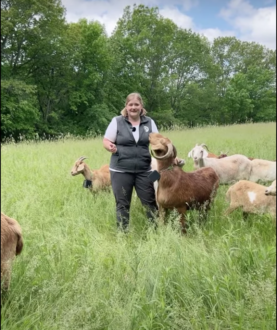Folks along the Saint Croix River in Minnesota and Wisconsin have a goat-for-hire company they can call for land clearing services or to manage unruly plants like buckthorn. Allysse Sorensen’s “Munch Bunch” goats tackle overgrown, rocky, and sloped areas to help control brush and weeds without herbicides. From May to October, Sorensen transports her goats to graze more than 100 acres in a season.
“I heard about targeted grazing with goats as a business at a conference,” said Sorensen. “Little did I know the job is mostly fencing, and it’s not as simple as just setting up and tearing down.”
The portable energized net fencing Sorensen was using to control the movement of her goats wasn’t a good match for her operation. She was curious if she could replace the net fencing with virtual fencing.
What is Virtual Fencing?
“Virtual fences are appealing because they require no wires in the ground but rely on a global positioning system (GPS) and cellular networks,” said Sorensen. “A virtual boundary of any shape or size can be created on a map, allowing the user to customize the area where the animals are contained.”
In 2021, with support from an $8,910 NCR-SARE Farmer Rancher grant, Sorensen compared virtual fencing with net fencing, looking at labor needs and overall effectiveness.
For her experiment, Sorensen used the virtual Nofence system. In this system, goats wear collars that consist of a rubber strap, a metal chain, and a battery housing with two solar panels on the sides to help charge the rechargeable battery (upper right). The herder uses a mobile phone or tablet application to set the boundaries. The app records animal movements and alerts when a perimeter has been breached. When a goat approaches a virtual boundary, the collar emits warning sounds. If the animal continues past the boundary, the device administers a three-kilovolt electric pulse through the collar’s chain.
To get started, Sorensen ordered collars for 30 wethers older than one year and non-lactating does; the breeds were Kiko, Boer, Nubian, and Myotonic. She trained the goats for about one week on the Nofence system and then set up paddocks. She added another 30 goats to the system in the second year and was pleased with the two-year project results.
Virtual Fence Findings
The system worked well for the Munch Bunch, and Sorensen intends to continue using virtual fencing in the future.
- The rechargeable batteries lasted between three weeks and three months.
- The system averaged 0.4 to 2 shocks a day during the training period. After the training period, Sorensen said it was normal to have no shocks daily.
- Collars fell off goats twice. Both times, it was due to improper fit, and Sorensen learned the collars were tighter than necessary.
- There was one virtual fence breach, which Sorensen was able to respond to immediately by adjusting the virtual fence on the app to adjust the containment boundaries.
- There were no incidences of predation.
- With virtual fencing, Sorensen saved, on average, three days per week on fence upkeep and replacement. It gave her more time for season extension and managing herd health.
“While portable net fencing may have its applications, due to current limitations in virtual fence technology, we plan on managing all goats primarily with Nofence in the future,” said Sorensen.
------
NCR-SARE’s Farmer Rancher Grant program starts accepting proposals in mid-August, with a deadline in December.
